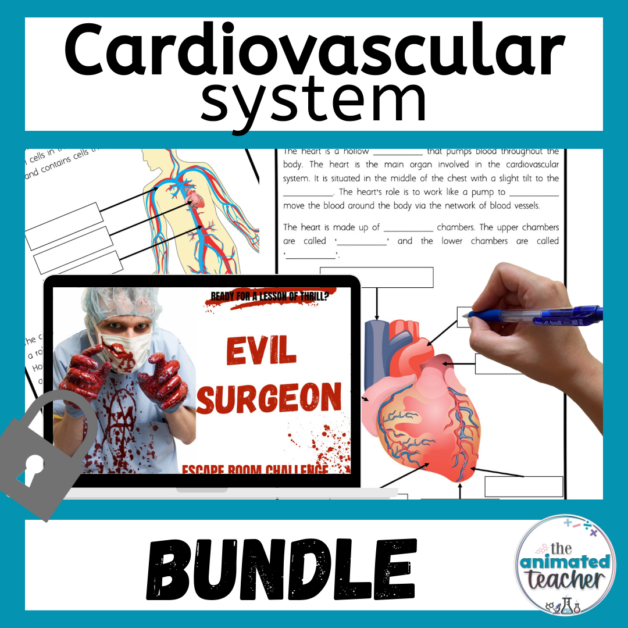Digestive and excretory system worksheets with answers and 3 activities
Original price was: $12.98.$11.68Current price is: $11.68.
The Digestive and Excretory System Worksheets and Stations will keep your students engaged while also ensuring they are covering key science content.
Please read the product description for digestive and excretory system worksheets with answers to make sure this product is right for you.
Understanding the key terms and the function of each part in the digestive and excretory system are so crucial for understanding how parts of the body work together. Sometimes it can feel like hard work to engage middle school students in reviewing key terms and consolidating their understanding. The Digestive and Excretory System Worksheets and Stations will keep your students engaged while also ensuring they are covering key science content. Need to differentiate for your class? No problem! There is a second option for the notes that can be used to challenge your students.
Why use the Digestive and Excretory System Worksheets and Stations?
1. Scaffolded notes provide support for students and ensures they have all the information for later revision
2. Stations information cards allow for movement and collaboration
3. Differentiated options included
4. Cut and paste activity allow for a change of pace in the classroom
5. Just print and go
6. Full teacher answers included
What format are the notes and stations in?
The pdf's are included in the zip file. An ink-saver version hasn't been included because the diagrams print well in greyscale.
What do the Digestive and Excretory Systems Worksheets and Stations consist of?
Excretory System:
This resource contains:
- 6 pages of scaffolded notes with diagrams to label
- 6 pages of a differentiated option with diagrams to label
- 6 pages of information stations
- 1 cut & paste flow chart activity
- Full teacher answers
Digestive System:
This resource contains:
- 7 pages of scaffolded notes with diagrams to label
- 7 pages of a differentiated option with diagrams to label
- 7 pages of information stations
- 2 activities - a cut & paste flow chart and a color coding activity to match the part, location and function.
- Full teacher answers
How do I use this resource?
Just print one copy of the notes for each student and one or two sets of stations (depending on the size of the class).
Students use the information cards at the various stations to complete their scaffolded notes and diagram labelling on:
EXCRETORY SYSTEM:
- The excretory system
- kidneys
- bladder
- nephrons
- lungs and liver
DIGESTIVE SYSTEM:
- The digestive system
- Mouth & Esophagus
- Liver
- Stomach
- Pancreas
- Small intestine
- Large Intestine
- Rectum & Anus
Students can then consolidate their understanding by completing the flow chart cut & paste activities.
Station Activities as an Instructional Strategy
Station-type worksheet activities are a valuable instructional strategy for teachers, offering various benefits for both educators and students. Here are several reasons for teachers to consider using station-type worksheet activities when creating lesson plans and teaching new content:
- Active Engagement: Station activities encourage active student participation. By moving between stations and completing different tasks, students are actively engaged in the learning process, promoting better retention of information.
- Differentiated Instruction: Stations allow for differentiation by providing various activities or levels of difficulty at each station. Teachers can tailor tasks to meet the diverse needs and learning styles of individual students, ensuring that everyone is appropriately challenged.
- Collaborative Learning: Students often work collaboratively at stations, fostering teamwork and communication skills. Collaborative learning promotes a sense of community in the classroom and allows students to learn from each other.
- Autonomous Learning: Station activities empower students to take ownership of their learning. As they navigate through different tasks independently or in groups, they develop a sense of responsibility and autonomy in their educational journey.
- Flexible Pacing: Stations provide flexibility in pacing, allowing students to move through activities at their own pace. This accommodates different learning speeds and ensures that students have sufficient time to grasp and master the content before moving on.
- Formative Assessment Opportunities: Teachers can embed formative assessments within station activities to gauge student understanding in real-time. This allows for on-the-spot adjustments to instruction based on student needs and misconceptions.
- Increased Motivation: The dynamic nature of station activities adds an element of excitement and variety to the learning environment. This increased motivation can positively impact student engagement and enthusiasm for the subject matter.
- Time Efficiency: Stations can optimize instructional time. While students are engaged in station activities, teachers can work with small groups or individuals, providing targeted support and feedback.
- Scaffolded Learning: Stations can be designed to scaffold learning, with each station building on the knowledge and skills acquired at the previous one. This structured progression helps students make connections and see the relevance of the content.
- Real-World Application: Station activities can simulate real-world scenarios, allowing students to apply their knowledge and skills in practical contexts. This application-oriented approach enhances the relevance of the content and its potential transferability to other situations.
The above reason are why I have created a set of stations for each of the human body systems worksheets suitable for 6th grade, 7th grade, 8th grade (middle school) students. Have a look at my resources on the other body systems including the nervous system, reproductive system, respiratory system, musculoskeletal system, and others.
Only logged in customers who have purchased this product may leave a review.
















Reviews
There are no reviews yet.